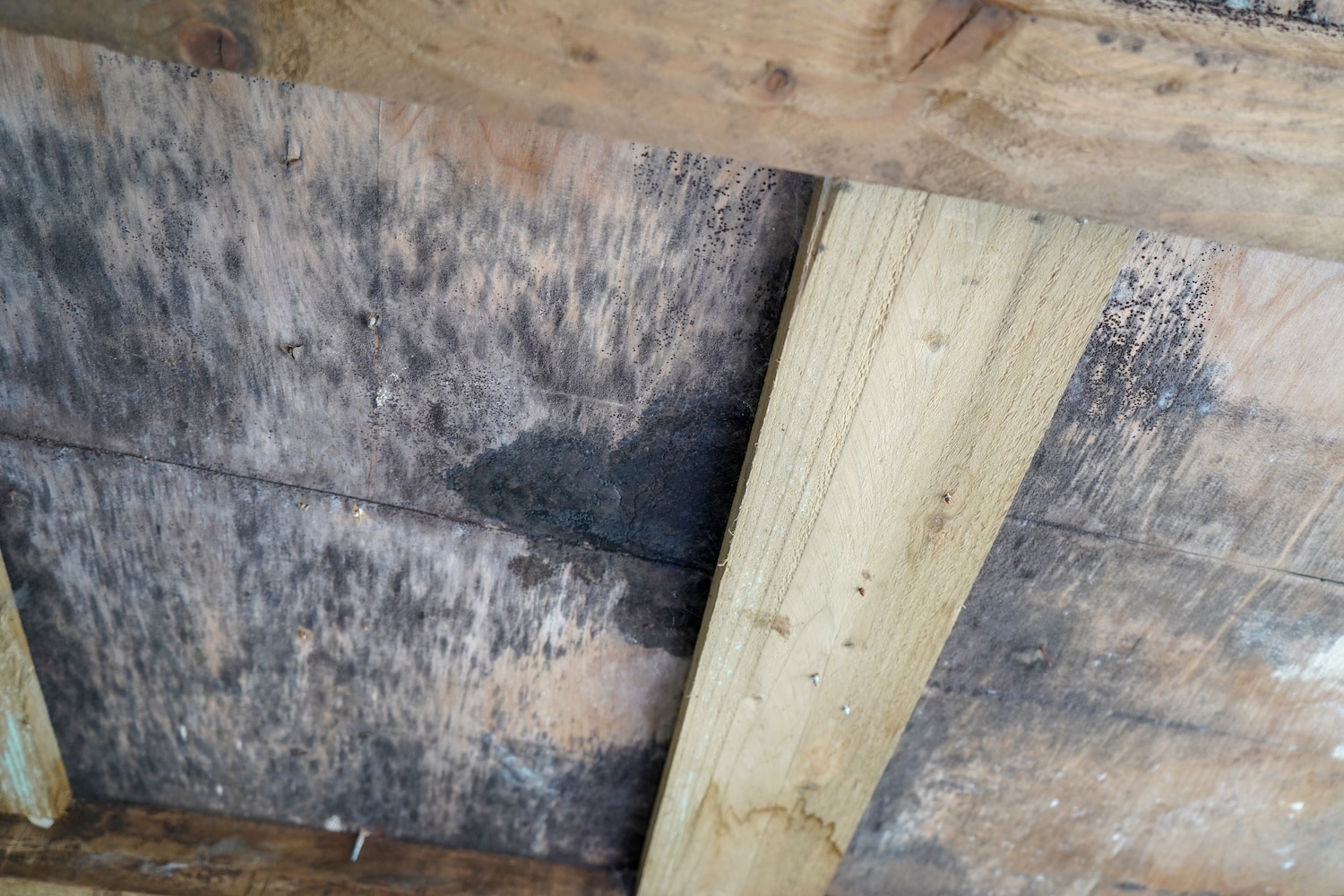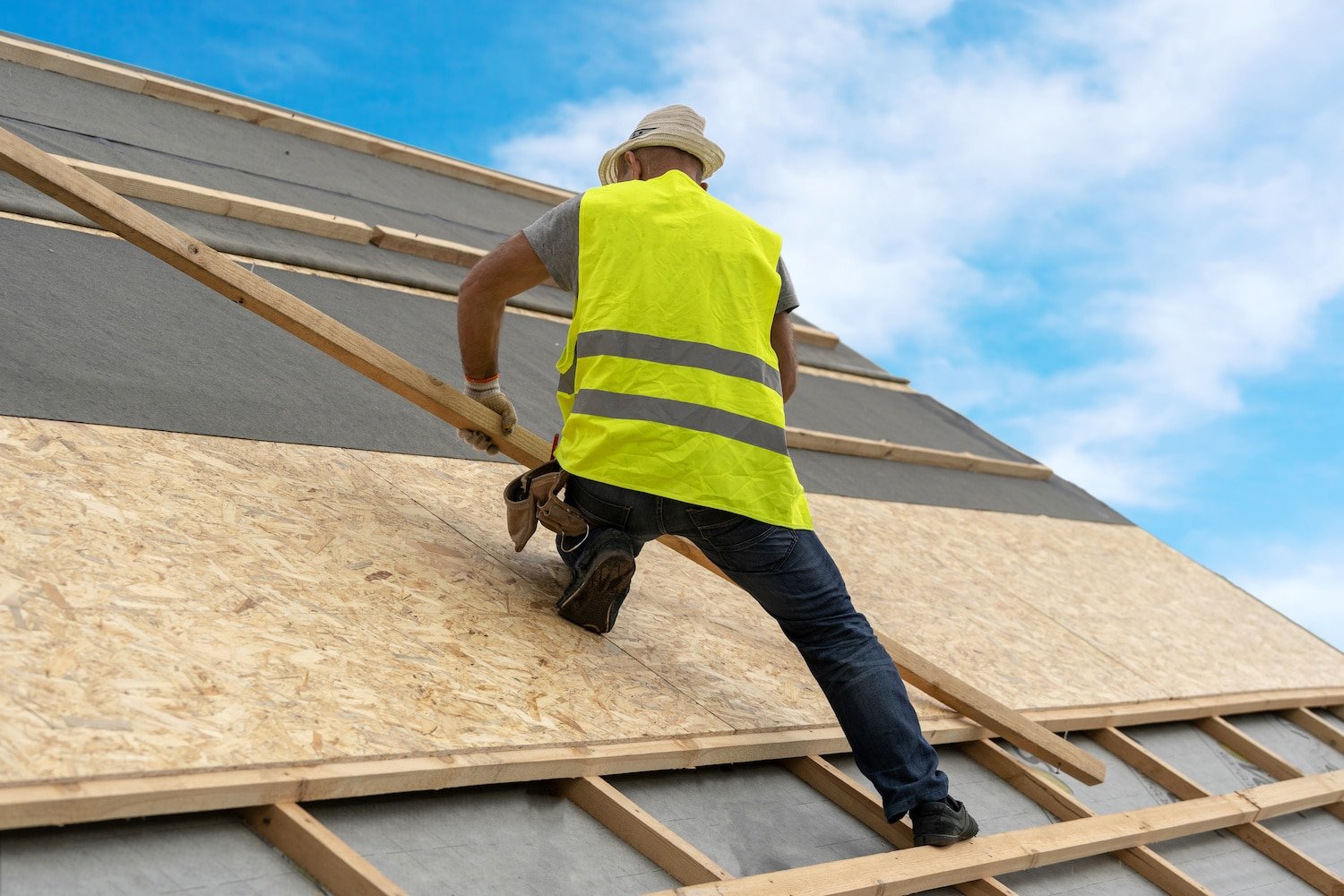You’re brave!
How’d we know that? Well, any homeowner that wants to learn how to redeck a roof on their own is definitely braver than the average person. Redecking a roof is no small task, but it’s a necessary one if your old decking is rotten.
Let’s take a closer look at:
- What roof decking is & its purpose
- Signs of rotten roof decking
- How to replace roof decking
Roof Decking: What It Is & Its Purpose
Roof decking is also commonly referred to as roof sheathing. It is the layer of plywood that gets attached to the trusses and joists of your roof frame. All other roofing materials are installed on top of the roof deck.
Primarily, roof sheathing exists to provide a flat surface for the roof underlayment and outermost materials (shingles, metal, etc.). Beyond that, roof decking serves the following purposes:
- Supports the Roofing Materials: Even lightweight roofing materials like asphalt shingles weigh 2-3 pounds per shingle! Your roof has to support a lot of weight, and the roof deck is the main load-bearing portion of a complete roofing system.
- Protects Against Water Damage: Your roof exists to keep out inclement weather and pests, right? The roof deck is the last line of defense against roof leaks and water damage, even if the rest of your roofing system has a fault.
- Fire Prevention: Flame retardants often get sprayed on plywood decking as an added measure to protect against fires. Not all roofers employ this practice, so be sure to get a professional opinion first.
How to Spot Rotten Roof Decking

We mentioned that roof sheathing acts as the last line of defense against water damage to your home. Unfortunately, if water sneaks past your shingles and felt underlayment, it can eventually cause damage to your roof deck.
This damage manifests as rot. If your roof deck develops rot, it needs to be replaced quickly because it can cause problems such as:
- Mold and fungus growth, which reduces air quality in your home
- Bowing or bulging rood deck, which threatens a roof collapse
- Damaged insulation
- Rot spreading to other wood in your home
You can spot a rotten roof deck based on these indicators:
- Black, white, yellow, gray, or brown discolorations and growths
- Spongey and weak wood
- Plywood that’s darker in some spots
- Musty smells
- Easily crumbling or cracking wood
Most roof replacements don’t include new roof decking off the bat since it can last for decades. But as soon as rotten decking is spotted, it must be replaced ASAP. Most roofing professionals can tell when a roof deck is rotten just by stepping foot on your roof and noticing the spongey feel.
However, homeowners may not notice until the deck starts to sag or mold begins to spread into your home.
5 Steps for Redecking a Roof
Replacing rotted roof decking is a large task. You’ll need to set aside lots of time and patience if you’re going to attempt this project yourself instead of calling a professional.
Step 1: Remove the Shingles and Underlayment
You can try to estimate the scope of the damage on your sheathing beforehand, but the only way you can really know for sure is to remove the materials on top of it.
You’ll have better luck if you tackle this roofing project with at least one other person. (It’s good for safety reasons too!) Otherwise, you’ll exhaust yourself with the tedious nature of removing the shingles, nails, and underlayment.
Use a pry bar to lift the shingles and nails out of their place. Start at your roof’s peak and work your way down. Once all the shingles are removed, you can remove the layer of felt underlayment to expose your roof decking.
- Note: Walking on rotten roof decking is very dangerous. If you don’t feel confident in your ability to avoid weak areas of your sheathing, call a professional instead. Scaffolding may need to be used if the roof isn’t safe to walk on.
Step 2: Measure the Rotten Area
Once your roof deck is exposed, you’ll get a clear picture of how much of your roof decking is rotten. If it’s only one small area, you’ll only have to replace one small area! But if it’s covering the majority of your roof deck, you’re best off replacing all of it.
Step 3: Remove the Rotted Wood

Use a saw to carefully remove the rotten decking. Take extra caution not to cut the rafters below. If any rafters are damaged, they must be replaced before installing the new decking.
Step 4: Cut New Decking to Fit
Plywood decking comes in 4-foot by 8-foot sheets. You’ll need to cut the decking to accurately fit into the area in need of replacement (which may be the entire roof). The new decking should be the same thickness as the old decking so that the materials still lay flat on top of it.
Step 5: Position and Secure the New Decking
Position the decking over your rafters. Make any last-minute trims to ensure the measurements are completely accurate. When the decking is in place, secure it with roofing nails.
Please, We Beg of You, Leave This One to the Professionals
Since you have to tear off all your shingles and perform a total roof replacement for this task, we highly, highly recommend hiring a professional roofing company instead. It’s an exhausting, tedious, and complicated project, and one wrong move could dramatically risk your safety (and finances).
This is a hefty task even for a full crew of trained roofing professionals, so it is incredibly difficult for laymen with no previous experience.
If you live in Minnesota or Wisconsin and need roofing support, give Level Edge Roofing a call! Our in-house team of experienced roofers will perform the necessary service for your roof to keep your home and family protected.
Reach out today for a free inspection!
FAQ
Can you put new plywood over old on a roof?
Yes, you can add new plywood over old roofing if it’s in good condition.
Should you replace plywood on a roof?
Replace plywood on a roof if it’s damaged or shows signs of rot or decay.
How do you fix rotted wood under a roof?
To fix rotted wood under a roof, remove damaged sections, replace with new plywood, and ensure proper sealing and waterproofing.